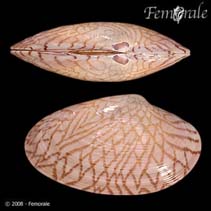Paratapes undulatus (Born, 1778)
Undulate venus
Classification / Names Populärnamn | synonymer | CoL | ITIS | WoRMS
Bivalvia | Venerida | Veneridae
Environment: milieu / climate zone / djupintervall / distribution range Ekologi
; djupintervall 0 - 50 m (Ref. 348). Tropical; 42°N - 38°S, 32°E - 154°E
Distribution Länder | FAO områden | Ekosystem | Förekomster | Utplanteringar
Indo-West Pacific: Red Sea, to Papua New Guinea; north to Japan and south to New South Wales.
Length at first maturity / Size / Weight / Age
Könsmognad: Lm ?, range 4 - ? cm Max length : 6.5 cm SHL hane/ej könsbestämd; (Ref. 348); common length : 5.0 cm SHL hane/ej könsbestämd; (Ref. 348)
Life cycle and mating behavior Könsmognad | Reproduktion | Lek | Eggs | Fecundity | Larvae
Main reference
referenser | Koordinator | Medarbetare
SAUP Database 2006 SAUP Database. www.seaaroundus.org. (Ref. 356)
IUCN Red List Status
(Ref. 130435: Version 2025-1)
CITES status (Ref. 108899)
CMS (Ref. 116361)
Threat to humans
Human uses
Fiskeri: kommersiell
| FishSource | Sea Around Us
Verktyg
Ytterligare information
Internet-källor
BHL | BOLD Systems | CISTI | DiscoverLife | FAO(Publication : search) | Fishipedia | GenBank (genome, nucleotide) | GloBI | Gomexsi | Google Books | Google Scholar | Google | PubMed | Tree of Life | Wikipedia (Go, sök) | Zoological Record



